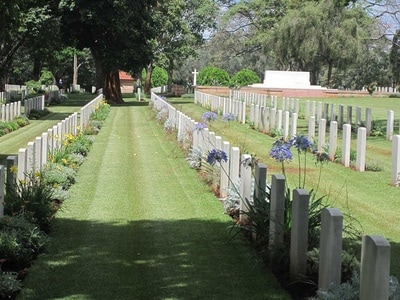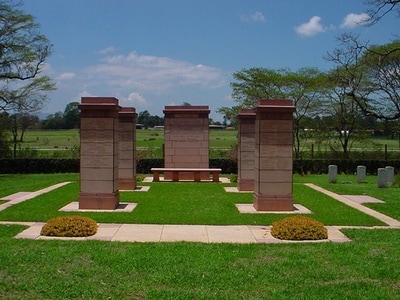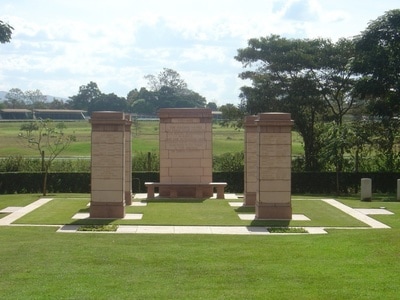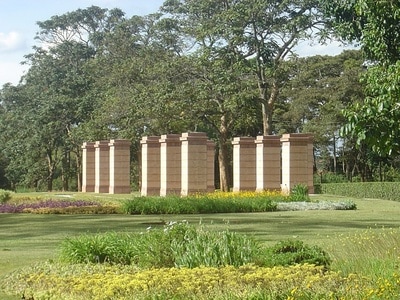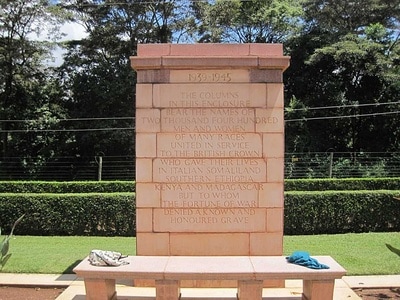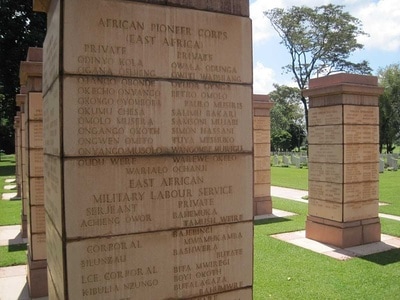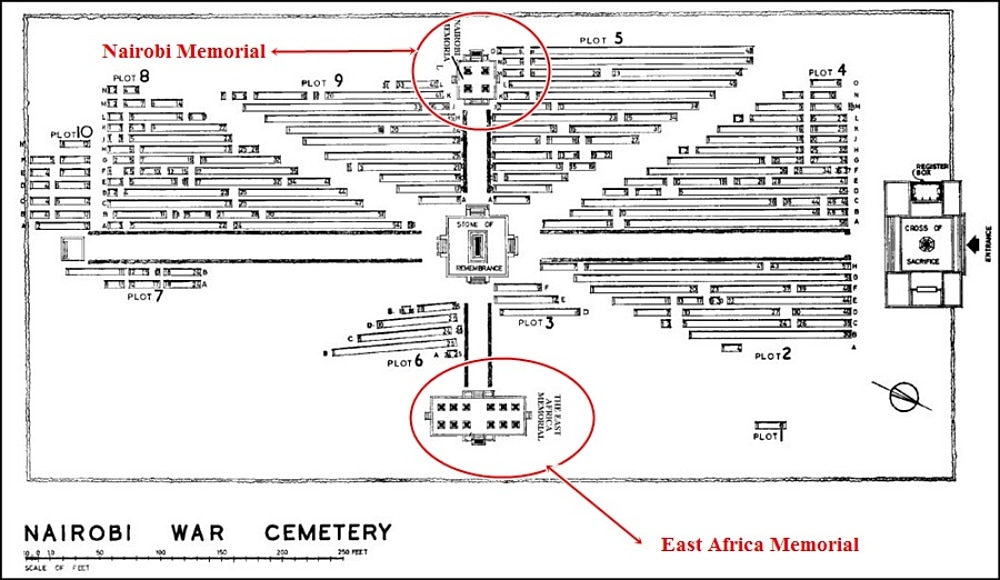NAIROBI WAR CEMETERY, NAIROBI MEMORIAL AND EAST AFRICA MEMORIAL
Nairobi
Kenya
Location Information
The War Cemetery is on the south-western outskirts of Nairobi, about 10 kilometres west of the city centre on Ngong Road, which is the main road to the Government Forest Reserve.
The cemetery is adjacent to Nairobi race course and is included within the Ngong Forest Reserve. It is reached by way of a long driveway off Ngong Road, the turning being indicated by a CWGC direction sign.
Visiting Information
Nairobi War Cemetery is open every day between 06:00 and 18:00. Wheelchair access to this site is possible, but may be via an alternative entrance.
Kindly note that there have been reported attacks in the vicinity of the cemetery therefore all visitors are strongly advised to take care and not carry any valuables when visiting the site. Visitors are strongly advised not to walk along the 1km access track to the cemetery from the main road but should travel to the cemetery entrance by vehicle only. Visitors are also advised that a troop of wild monkeys often frequent the access road and the cemetery. Visitors should not approach or feed the monkeys as they can bite and scratch if frightened.
Historical Information
During the Second World War, Nairobi was the headquarters of the East African Force and the base for the conquest of Jubaland and Italian Somaliland, the liberation of British Somaliland and the sweep north-westwards to open Addis Ababa for the return of the Emperor. It was also a hospital centre; No.87 British General Hospital arrived in June 1943 and was still there in December 1945, while No.150 British General Hospital was there for a period in 1943.
The war cemetery was opened in 1941 by the military authorities. Besides the original burials, numerous graves were transferred to this cemetery from African civil cemeteries and temporary army burial grounds at Garissa, Gelib, Kinangop, Marsabit, Mega and other inaccessible places, so that it is now the largest war cemetery in East Africa.
NAIROBI WAR CEMETERY now contains 1,952 Commonwealth burials of the Second World War, 11 of which are unidentified. There are also 76 non-war burials and one French grave. It was designed by G. Vey.
Within the cemetery is the EAST AFRICAL MEMORIAL, which commemorates men of the land forces who lost their lives in the advance from the south into Italian Somaliland and Ethiopia and during the occupation of those territories, and who have no known grave. Along with them are honoured those who died during the operations in Madagascar in 1942 and who have no known grave. Besides those who died in these campaigns, many men who were lost in the sinking of the troopship 'Khedive Ismail' en route to Ceylon on 12 February 1944 are commemorated here; they include a great part of the 301st Field Regiment, East African Artillery.
The cemetery also contains the NAIROBI MEMORIAL which commemorates 477 men of the United Kingdom, South African, and East African Forces who died in the non-operational zones of Kenya whilst in training, or on lines of communication or garrison duty, and whose graves could not be located or are so situated as to be unmaintainable.
Cemetery and Memorial pictures used with the permission of the Commonwealth War Graves Commission
The War Cemetery is on the south-western outskirts of Nairobi, about 10 kilometres west of the city centre on Ngong Road, which is the main road to the Government Forest Reserve.
The cemetery is adjacent to Nairobi race course and is included within the Ngong Forest Reserve. It is reached by way of a long driveway off Ngong Road, the turning being indicated by a CWGC direction sign.
Visiting Information
Nairobi War Cemetery is open every day between 06:00 and 18:00. Wheelchair access to this site is possible, but may be via an alternative entrance.
Kindly note that there have been reported attacks in the vicinity of the cemetery therefore all visitors are strongly advised to take care and not carry any valuables when visiting the site. Visitors are strongly advised not to walk along the 1km access track to the cemetery from the main road but should travel to the cemetery entrance by vehicle only. Visitors are also advised that a troop of wild monkeys often frequent the access road and the cemetery. Visitors should not approach or feed the monkeys as they can bite and scratch if frightened.
Historical Information
During the Second World War, Nairobi was the headquarters of the East African Force and the base for the conquest of Jubaland and Italian Somaliland, the liberation of British Somaliland and the sweep north-westwards to open Addis Ababa for the return of the Emperor. It was also a hospital centre; No.87 British General Hospital arrived in June 1943 and was still there in December 1945, while No.150 British General Hospital was there for a period in 1943.
The war cemetery was opened in 1941 by the military authorities. Besides the original burials, numerous graves were transferred to this cemetery from African civil cemeteries and temporary army burial grounds at Garissa, Gelib, Kinangop, Marsabit, Mega and other inaccessible places, so that it is now the largest war cemetery in East Africa.
NAIROBI WAR CEMETERY now contains 1,952 Commonwealth burials of the Second World War, 11 of which are unidentified. There are also 76 non-war burials and one French grave. It was designed by G. Vey.
Within the cemetery is the EAST AFRICAL MEMORIAL, which commemorates men of the land forces who lost their lives in the advance from the south into Italian Somaliland and Ethiopia and during the occupation of those territories, and who have no known grave. Along with them are honoured those who died during the operations in Madagascar in 1942 and who have no known grave. Besides those who died in these campaigns, many men who were lost in the sinking of the troopship 'Khedive Ismail' en route to Ceylon on 12 February 1944 are commemorated here; they include a great part of the 301st Field Regiment, East African Artillery.
The cemetery also contains the NAIROBI MEMORIAL which commemorates 477 men of the United Kingdom, South African, and East African Forces who died in the non-operational zones of Kenya whilst in training, or on lines of communication or garrison duty, and whose graves could not be located or are so situated as to be unmaintainable.
Cemetery and Memorial pictures used with the permission of the Commonwealth War Graves Commission
Nairobi War Cemetery
Nairobi Memorial
East Africa Memorial
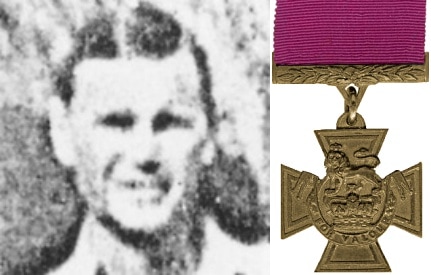
LF/145 Serjeant Nigel Gray Leakey, V. C.
1/6th Bn. King's African Rifles, died 19th May 1941, ahed 28. Column 37.
Son of Arundell Gray A. and Elizabeth Leakey, of Kiganjo, Kenya.
Citation: The citation in the London Gazette of 15th November, 1945, gives the following particulars: On 19th May, 1941, at Colito, Abyssinia, two companies of the 1/6th The King's African Rifles crossed the Billate River and established a precarious bridgehead. The enemy launched a surprise counter-attack with tanks. With complete disregard for his own safety and in the face of withering fire, Serjeant Leakey leaped on top of a tank coming from behind the British positions, wrenched open the turret and shot the crew except the driver, whom he ordered to drive to cover. He then charged across open ground under fire and with three of the African troops stalked the other tanks. He succeeded in jumping on to the third tank, and opened the turret and killed one of the crew before being shot off by the fourth tank. His determination and his initiative were responsible for breaking up the Italian tank attack, and for saving a most critical situation. The superb courage and magnificent fighting spirit which he displayed, facing almost certain death, was an incentive to his comrades, who fought on with inspiration after witnessing his gallantry and succeeded in retaining their positions in the face of great odds.
1/6th Bn. King's African Rifles, died 19th May 1941, ahed 28. Column 37.
Son of Arundell Gray A. and Elizabeth Leakey, of Kiganjo, Kenya.
Citation: The citation in the London Gazette of 15th November, 1945, gives the following particulars: On 19th May, 1941, at Colito, Abyssinia, two companies of the 1/6th The King's African Rifles crossed the Billate River and established a precarious bridgehead. The enemy launched a surprise counter-attack with tanks. With complete disregard for his own safety and in the face of withering fire, Serjeant Leakey leaped on top of a tank coming from behind the British positions, wrenched open the turret and shot the crew except the driver, whom he ordered to drive to cover. He then charged across open ground under fire and with three of the African troops stalked the other tanks. He succeeded in jumping on to the third tank, and opened the turret and killed one of the crew before being shot off by the fourth tank. His determination and his initiative were responsible for breaking up the Italian tank attack, and for saving a most critical situation. The superb courage and magnificent fighting spirit which he displayed, facing almost certain death, was an incentive to his comrades, who fought on with inspiration after witnessing his gallantry and succeeded in retaining their positions in the face of great odds.



